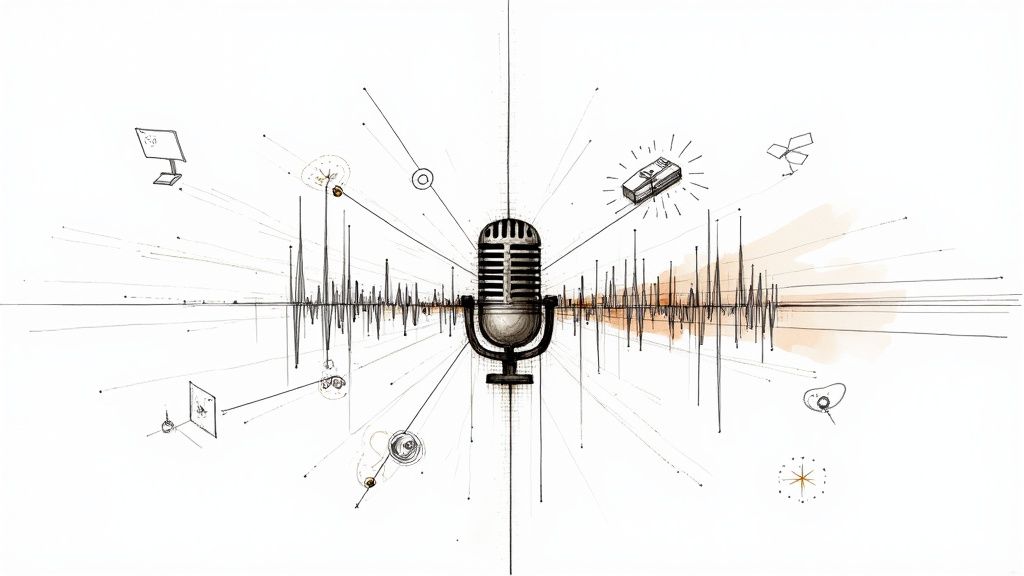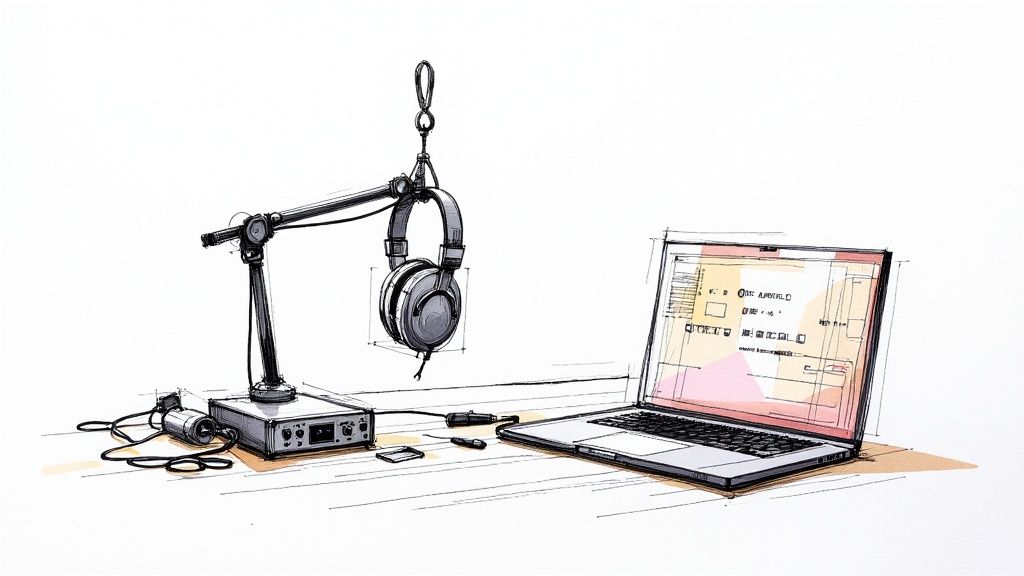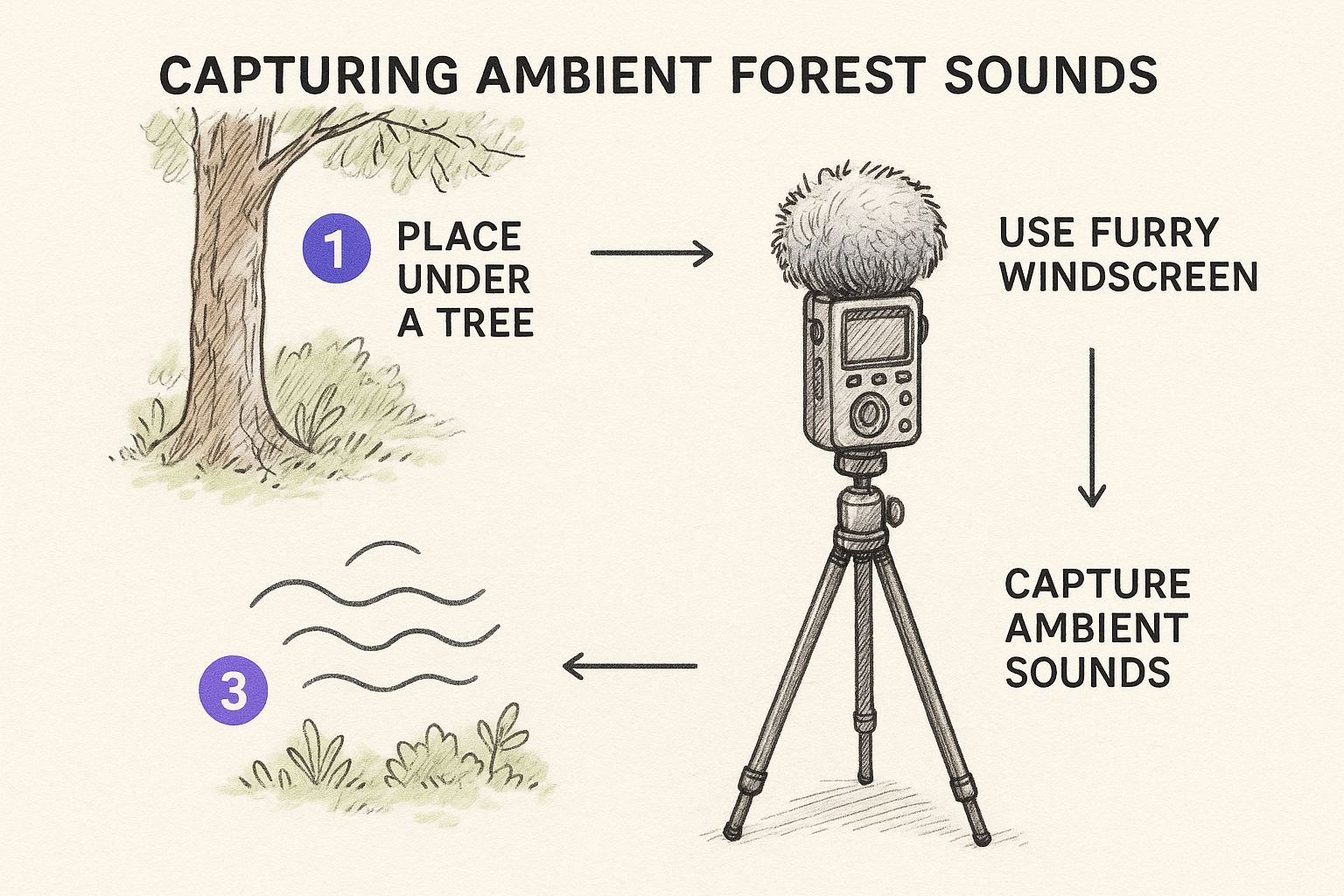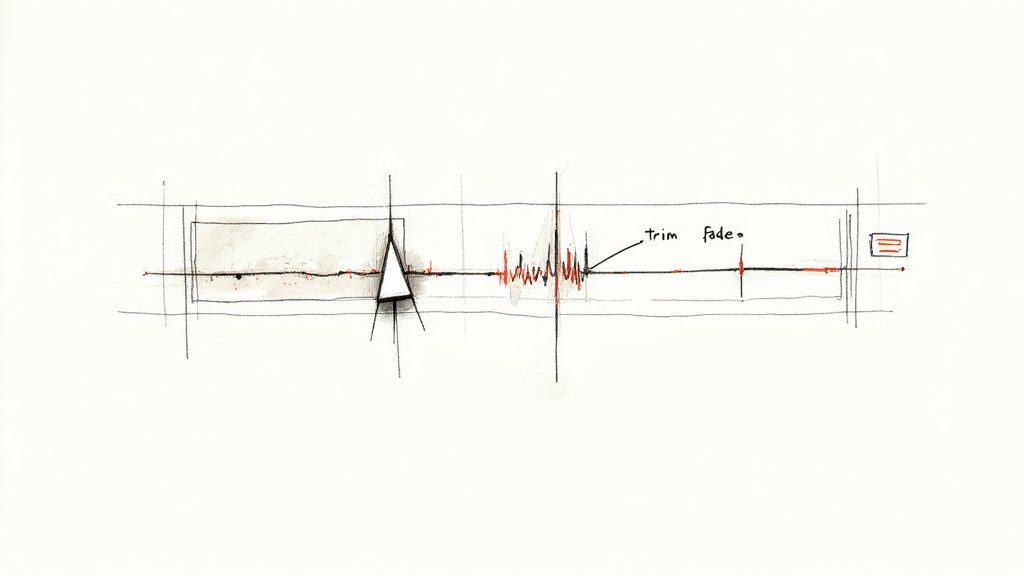How to Create Sound Effects From Scratch

Ever wondered how sound designers create the satisfying crunch of footsteps on gravel or the otherworldly hum of a spaceship? Learning how to create sound effects is an incredible skill that sits right at the crossroads of technical wizardry and raw creativity.
This guide is your map into that world. Whether you're a filmmaker who needs custom audio, a game developer building an immersive universe, or a podcaster trying to make your show stand out, we've got you covered with actionable insights.
Your Journey Into Sound Creation
Making your own sound effects is a game-changer. It's the difference between grabbing a generic, overused file and crafting an audio signature that's entirely yours. The best part? It's more accessible than you think.
We're going to break down the three core paths you can take to make truly unique sounds that will stick with your audience.
The Three Paths to Audio Excellence
Forget the idea that you need a Hollywood-sized studio. Great sound design starts with knowing your options, and each one has its own unique power.
- Recording Real-World Objects (Foley): This is the classic, hands-on art of capturing sound from your environment. Think snapping celery sticks for bone breaks or flapping a leather jacket for the sound of wings. It’s pure creativity and guarantees your audio is 100% original.
- Digital Sound Synthesis: Here, you'll use a Digital Audio Workstation (DAW) to build sounds from the ground up. By manipulating digital waveforms, you can create anything from a simple UI beep to a complex, layered sci-fi drone.
- AI-Powered Generation: This is the new frontier. Tools like Verbatik’s AI sound effect generator tool let you dream up almost any sound with a simple text prompt. It's the most actionable way to create sounds that are impossible or just plain impractical to record in the real world.
The most compelling soundscapes are often built by combining all three methods. You might record a real-world door creak, layer it with a synthesized low-frequency rumble, and add an AI-generated gust of wind to create a truly atmospheric and unique effect.
This guide will walk you through blending these techniques. If you're curious to dive deeper into AI's role, check out our guide on the best AI sound maker tools for a closer look.
But it doesn't stop at sound effects. Platforms like Verbatik also offer unlimited text to speech and voice cloning, giving you a complete audio toolkit. This means you can create not just the world's ambiance but also custom character dialogue and narration, all in one place. When you master these tools, you have total control over your project's sound, making sure every single noise serves a purpose and elevates your story.
Grasping the Fundamentals of Sound Design
Before you even think about hitting record or generating an effect, you need to know what you're working with. I like to think of a sound designer as a chef—you have to understand your ingredients before you can even dream of creating a masterpiece. Every single sound, from a pin drop to a volcanic eruption, is made from the same core components.

Getting a handle on these principles is the real first step in learning how to create sound effects that actually land with an audience. Forget the complex physics for now; this is all about training your ear to know what sounds right.
The Building Blocks of Every Sound
When you strip it all away, every sound effect boils down to three main characteristics. Getting a feel for how these play together is how you'll learn to shape any piece of audio to match your vision.
- Amplitude (Volume): This one's easy—it's just how loud or soft a sound is. But don't underestimate it. Amplitude is your secret weapon for creating dynamic range and emotional punch. A sudden jump in volume can make someone leap out of their seat, while a slow fade-out can build unbearable tension.
- Frequency (Pitch): This is all about the high and low notes of a sound. Low frequencies are those deep rumbles and booms you feel in your gut. High frequencies give you the crisp, sharp sounds like hisses, clicks, and shimmers.
- Timbre (Tonal Quality): This is the magic ingredient—the unique "color" or texture of a sound. It’s the reason a trumpet and a piano playing the exact same note sound worlds apart. Timbre is what makes a sound feel wooden, metallic, breathy, or full.
Think of these three elements as the primary colors of sound. By mixing different levels of amplitude, frequency, and timbre, you can create an infinite palette of auditory experiences, from the mundane to the fantastical.
The Power of Layering
Here's a pro tip: a single recorded sound almost never cuts it. The real secret to rich, professional sound design is layering. A blockbuster movie explosion isn't just one big "boom." It's a carefully crafted stack of different audio tracks, each doing a specific job.
For instance, that huge movie explosion might be built like this:
- A low-frequency boom for that initial, chest-thumping impact.
- Some mid-range crackle and crunch to simulate the fire and burning debris.
- A high-frequency sizzle or tinkle to represent shattering glass and shrapnel flying past.
Each layer carves out its own space in the frequency spectrum, and when they come together, they create a sound far more believable and complex than any single recording could. This isn't just for explosions, either. The same logic applies to a simple footstep (the sole, the surface, the clothing rustle) or a complex magical spell.
Categorizing Sounds for Your Projects
To keep your workflow from getting chaotic, it helps to think about sounds in categories. This simple framework helps you figure out what your project is missing and how each new sound will serve the overall atmosphere.
- Ambience: These are your background tracks that set the scene. Think of the low hum of a forest at night, the distant drone of city traffic, or the sterile buzz of a spaceship corridor.
- Foley: This is where things get hands-on. Foley sounds are created by human interaction—footsteps on gravel, the rustle of a jacket, or the thud of a punch. They're usually performed and recorded in sync with the action on screen to add a layer of realism.
- Spot Effects: These are the specific, one-off sounds tied to a distinct event. A gunshot, a door slamming shut, a phone ringing—these are all spot effects.
Getting this structured approach down is more important than ever. The global market for sound effects services was valued at around USD 1.25 billion and is projected to nearly double by 2033. Why? Because audiences are demanding high-quality, immersive audio in their games, films, and podcasts. You can dig into the numbers yourself over at Verified Market Reports. This trend shows a huge opportunity for creators who take the time to master these fundamentals.
Assembling Your Sound Creation Toolkit
Every sound designer needs a good set of tools, and learning how to create sound effects starts with building your workshop. The good news? You don't need to break the bank. It's all about making smart choices that fit what you're trying to accomplish.
The heart of any modern audio setup is your software. Think of it as your digital command center.
Picking Your Digital Audio Workstation
The most critical piece of software you'll use is a Digital Audio Workstation (DAW). This is your virtual studio where all the magic happens—recording, editing, layering, and mixing your sounds into a final, polished piece. The options run the gamut from totally free to the high-end suites you'd find in a Hollywood studio.
If you’re just dipping your toes in, free DAWs are surprisingly powerful these days. Audacity is a classic for a reason. It’s open-source, straightforward, and has everything you need for basic recording and editing. It’s the perfect sandbox for learning the ropes without spending a dime.
Once you feel you're hitting a creative ceiling, you can look at the industry standards. Tools like Pro Tools, Logic Pro (for the Mac crowd), or Ableton Live offer a much deeper well of features, from advanced plugins to complex routing that the pros depend on. My advice is always to start simple and only upgrade when your projects demand more power.
Gear for Capturing Real-World Audio
Software is only half the battle. You’ll need some hardware to actually capture sound from the world around you. A quality microphone is probably the best first investment you can make. You don’t need the most expensive one on the shelf, but a decent condenser or dynamic mic will pick up so much more detail than your phone ever could.
For grabbing sounds on the go, a dedicated field recorder is a must-have. Little powerhouses from brands like Zoom or Tascam are built for this. They're portable, tough, and designed to record clean, high-fidelity audio just about anywhere.
This infographic gives you a great idea of a simple, effective field recording setup.

As you can see, you really don't need a massive, intimidating studio to capture professional-grade ambient sound. A portable rig can be incredibly powerful.
The New Frontier: AI-Powered Tools
Today's sound design toolkit looks a lot different than it did even a few years ago, thanks to AI. With the explosion of content on platforms like YouTube and TikTok, creators need every edge they can get. AI is making pro-level tools more accessible than ever before, and it's completely changing the game.
This is where platforms like Verbatik step in, offering a whole new way to think about sound creation.
The most powerful workflow often combines the best of all worlds: record what you can, synthesize what you can't, and use AI to fill the gaps and spark new ideas. This hybrid approach gives you maximum creative flexibility.
Imagine you need the roar of a dragon or the hum of a futuristic engine. Good luck recording that in the wild. With Verbatik's AI sound effect generator tool, you can create these impossible sounds just by typing out a description. It's a massive time-saver and unlocks creative avenues that used to be out of reach. You can test this out yourself in Verbatik’s all-in-one Sound Studio, where generated effects can be mixed right alongside your own recordings.
But it doesn't stop at sound effects. Verbatik also offers unlimited text to speech and voice cloning. This is a huge asset. You can generate custom dialogue for characters, create alien vocal textures, or produce clean narration for a video—all within the same ecosystem. Having these tools integrated means you can build a complete, professional soundscape from scratch.
Comparing Sound Effect Creation Methods
Choosing the right method for creating sound effects depends entirely on your project's needs, timeline, and budget. Here’s a quick breakdown of the main approaches to help you decide which path to take.
| Method | Description | Pros | Cons |
|---|---|---|---|
| Field Recording | Capturing real-world sounds with microphones and a recorder. | • Highly authentic and unique • Great for ambient backgrounds • Fun and rewarding process | • Time-consuming • Can be expensive (gear) • Dependent on location/weather |
| Foley | Performing and recording sounds in sync with picture, often in a studio. | • Perfectly synchronized to action • Total creative control • Creates subtle, realistic details | • Requires a dedicated space • Labor-intensive • Needs lots of props |
| Synthesizing | Creating sounds from scratch using digital synthesizers. | • Limitless creative potential • Ideal for sci-fi/fantasy • No need for physical recording | • Steep learning curve • Can sound artificial if not done well • Requires specialized software/plugins |
| AI Generation | Using text prompts to generate sounds with an AI model. | • Incredibly fast • Creates impossible or abstract sounds easily • Excellent for ideation | • Less control over specifics • Quality can vary • Can lack the nuance of real recordings |
Ultimately, a hybrid approach often yields the best results. You might record a real door creak, synthesize a laser blast, and use AI to generate a creature's growl, all for the same project. The key is knowing what each tool does best.
The Art of Capturing Real-World Sounds
This is where the real fun begins. While AI and digital tools are fantastic, nothing beats the authenticity of capturing audio from your own environment. This technique, known as Foley or field recording, is the secret to building a library of sounds that is 100% yours, packed with character you just can't fake.

Let's walk through how you can get pristine recordings without a pro studio. You’ll be surprised how many incredible sounds are hiding right under your nose.
Building Your DIY Recording Space
You don't need a perfectly soundproofed room. Your main enemies are background noise and reverb (that echoey, bathroom sound). The goal is to find a quiet space with plenty of soft surfaces to absorb sound.
Ever noticed how quiet a walk-in closet full of clothes is? That's your blueprint. You can easily build a makeshift "vocal booth" by surrounding your mic with pillows, heavy blankets, or a thick duvet. This simple trick soaks up sound reflections, leaving you with a clean, focused recording to work with.
The Foley Artist's Shopping List
The best part about Foley is that the world is your instrument. Professional artists have been using these tricks for decades to create legendary movie sounds. Grab a few household items and see what you can create:
- Celery or Carrots: Snap them near the mic for some truly gnarly bone-breaking sounds.
- A Leather Jacket: Whoosh it around to simulate the flapping wings of a bird or even a dragon.
- A Staple Gun: That sharp thwack is perfect for a mechanical latch, a robot movement, or a punchy sci-fi gunshot.
- Old Cassette Tapes: Crinkling the tape sounds remarkably like a crackling fire or rustling leaves.
- A Heavy Book: Drop it onto different floors to mimic everything from a body fall to a heavy impact.
- Balloons: Inflate one and rub the surface to get all sorts of weird creature squeals and monster groans.
Getting hands-on like this is fundamental to learning how to create sound effects that feel genuine. It literally trains your ears to hear the sonic potential in everyday objects.
Here's a pro tip every sound designer learns: an object rarely sounds like what you think it should. The real art is finding something that creates the feeling you're after, not necessarily the literal sound.
Mastering Microphone Placement and Levels
How you record is just as crucial as what you record. Where you place your microphone can completely change the character of the sound.
Moving the mic closer to the source boosts "presence," capturing all the tiny details. But be careful of the proximity effect—a build-up of low frequencies that can make things sound boomy. Sometimes that’s perfect for a massive impact, but for a delicate paper rustle, you’ll want to pull the mic back a bit.
Setting your recording level is just as important. You want to record as loud as you can without clipping, that nasty digital distortion you get when the signal is too hot. A solid rule of thumb is to have your audio levels peak between -12dB and -6dB. This gives you a strong, clean signal with enough headroom to avoid distortion if the sound suddenly gets louder.
Of course, recording your own sounds isn't always practical. When you need something impossible to capture—like an erupting volcano or a dinosaur roar—remember that AI is your best friend. You can instantly generate thousands of options from libraries like Verbatik's sound effects library.
The best workflow often blends the raw grit of field recording with the sheer speed of AI. A tool like Verbatik gives you a complete audio suite, combining its AI sound effect generator tool with unlimited text to speech and voice cloning. You can record your own footsteps, generate an alien monster screech with AI, and then add custom dialogue—all within one platform. That’s total creative freedom.
Editing and Transforming Your Raw Audio
https://www.youtube.com/embed/uo8PLlI6ksQ
A raw audio recording is just the starting point. The real magic happens in post-production, where you get to sculpt and breathe life into a sound inside your Digital Audio Workstation (DAW). It’s like taking a rough block of marble and carving out a masterpiece. This is how you turn basic clips into polished, professional assets ready for any project.
Before we get to the fun stuff, though, we have to do some cleanup. This foundational work ensures your creative edits aren't built on a shaky, noisy base. It might feel like grunt work, but it’s an absolutely essential part of learning how to create sound effects that sound clean and intentional.
Cleaning and Preparing Your Audio
First things first, you need to clean house. The first thing I always do is trim the fat. Go through and chop out any dead air at the beginning and end of the clip. While you're at it, slice out any unwanted noises like coughs, mic bumps, or chair squeaks between the parts you actually want to keep. This simple step tightens up the file and makes it much easier to manage.
Next up is tackling background noise. Even in what you think is a perfectly quiet room, your mic will pick up the subtle hiss from your equipment or the low rumble of an air conditioner. A good noise reduction tool in your DAW can gently scrub this away, making your main sound pop. A word of caution: be gentle. If you push it too far, the audio will start to sound thin, watery, and unnatural.
Finally, I normalize the audio. Normalization is a simple process that boosts the entire clip's volume so that its loudest peak hits a consistent level—usually just below 0dB to avoid any nasty digital clipping. This ensures all your sounds have a similar loudness, which is critical when you start mixing them together later on. For anyone serious about quality, file formats matter. If you want a deeper dive, our guide on how to download a WAV file breaks down why this lossless format is the professional standard.
Shaping the Sonic Character
With a clean, prepped file, you can finally start the artistic part: shaping your sound. This is where you pull out the effects to define its texture, give it impact, and place it in a believable space.
Your most powerful shaping tool here is the Equalizer (EQ). An EQ is basically a sophisticated tone control, letting you boost or cut specific audio frequencies to completely change a sound's character. For instance:
- Want more power? Boost the low frequencies to add weight and boom to an explosion or a heavy footstep.
- Sound a bit muddy? Cut some of the cluttered mid-frequencies to instantly clean up a recording.
- Need more definition? A little boost in the high frequencies can add crispness and clarity to a metallic clang or rustling leaves.
To give your sounds punch and keep their volume under control, you absolutely have to get your head around understanding audio compression. A compressor tames the dynamic range of a sound by making the loud parts a bit quieter and the quiet parts a bit louder. This adds punch and perceived loudness, making the sound feel more consistent and preventing it from jumping out of the mix unexpectedly.
Use reverb to place your sound in a specific environment. A short, tight reverb can make a sound feel like it’s in a small room, while a long, cavernous reverb can transport it to a massive cathedral or an open canyon. Context is everything.
Unleashing Advanced Creative Techniques
Once you've nailed the basics, you can start pushing the boundaries and twisting your sounds into something completely new. This is where you can really let your imagination run wild.
Layering is a core technique for creating complex and rich sounds. A single sound effect is rarely enough. A great trick is to layer a real-world recording with something synthetic. For example, Verbatik’s AI sound effect generator tool can produce a deep, sci-fi hum that you can layer under a recording of a whirring kitchen blender to create a futuristic machine sound.
Don't be afraid to get weird and manipulate the audio itself.
- Pitch-Shifting: Take a cute kitten's meow, pitch it way down, and you might just have the menacing growl of a giant monster.
- Reversing Audio: A reversed cymbal crash is a classic "riser" effect that builds tension perfectly before a big reveal or impact.
- Time-Stretching: Slowing down a sound—sometimes drastically—can reveal incredible hidden textures and create deep, booming tones you never knew were there.
When you start combining these techniques, the possibilities become endless. You could record a simple pen click, layer it with a low-frequency thump generated by AI, pitch-shift the whole thing down, and add a touch of reverb to create a powerful sci-fi weapon sound. Verbatik's all-in-one platform is especially useful here, as it provides unlimited text to speech and voice cloning alongside its sound generator, allowing you to create every audio element for your project in one place.
Crafting Sounds for Interactive Media
Designing sound for video games is a whole different ballgame compared to linear media like film. You're not just scoring a scene; you're building a world that has to react, in real-time, to every single thing the player does. This means you have to think about sound in a more systemic, interactive way.
Take footsteps, for example. In a movie, you sync them to the action and you're done. In a game, if you just use one footstep sound, it'll repeat over and over, creating a fake, robotic "machine gun" effect that instantly pulls the player out of the experience. The trick is to create multiple variations—say, five slightly different recordings of a footstep on gravel—and let the game engine randomly pick one each time. It’s a simple change, but it makes the world feel infinitely more real.
Building Immersive and Responsive Worlds
Another classic technique is creating flawless audio loops. Think about the constant hum of a spaceship engine or the howl of wind across a frozen tundra. These ambient sounds need to loop perfectly, with no noticeable start or end, to create a truly convincing and unbroken environment for the player.
More than just background noise, sounds in games are a critical form of feedback.
- Confirmation Cues: That satisfying ping when you pick up an item? It’s a tiny reward that tells the player, "Yep, you got it."
- Warning Sounds: A subtle but clear alert for a nearby enemy gives players crucial information without needing a big pop-up on the screen.
- Impact Variations: The sound of a sword hitting a wooden shield versus a metal breastplate gives combat a tangible sense of weight and consequence.
This is a field that's absolutely exploding. The game sound design market, valued at USD 0.28 billion, is expected to jump to USD 0.68 billion by 2033. You can dig into some of the game sound design market trends to see just how fast it's growing. If you're looking to apply these audio skills in a related field, learning how to create compelling animation videos is a fantastic way to merge sound with visual storytelling.
This is where a tool like Verbatik's AI sound effect generator tool becomes incredibly useful. It lets you generate hundreds of unique variations for any sound in seconds, solving that "machine gun" problem instantly. Combine that with its unlimited text to speech and voice cloning for dynamic character dialogue, and you have a powerhouse for modern sound design in video games.
Your Top Sound Design Questions, Answered
As you dive into creating your own sound effects, you'll run into a few common questions. We all did. This is your quick guide to get those questions answered so you can get back to what matters: creating.
Do I Really Need Expensive Gear to Start?
Short answer: no. You can absolutely get started with the microphone on your smartphone and free software like Audacity.
Honestly, your most powerful tools are your own ears, your creativity, and a solid grasp of recording basics. Nail the fundamentals of capturing clean audio first. Worry about upgrading your gear later.
Foley vs. Sound Effects: What's the Deal?
This one trips a lot of people up, but it's pretty simple. Think of "sound effects" as the big category that covers everything.
Foley is just one type of sound effect. It’s the art of performing sounds in sync with the picture—things like footsteps, a jacket rustling, or a character picking up a glass. Sound effects is the umbrella term for Foley, plus ambiances, sci-fi lasers, explosions, and anything else you can imagine.
How Can I Make My Sounds More Believable?
Realism boils down to two things: layers and context. A single sound floating in space just doesn't feel right.
To sell an effect, you need to build it. A punch isn't just one sound; it’s the whoosh of the arm swinging, the dull thud of the impact, and the rustle of clothing. Once you have your layers, add a touch of reverb to place that sound in a physical space. It’s a small step, but it makes a world of difference.
My best advice? Combine the best of both worlds. Use your own recordings for that raw, authentic feel, and then turn to AI for speed and to create sounds that are physically impossible to capture yourself.
Should I Record My Own Sounds or Just Use AI?
There’s no right answer here—both approaches are incredibly valuable. Recording your own sounds gives you something completely unique and authentic that no one else has. It's your signature.
On the other hand, an AI sound effect generator tool like Verbatik is a lifesaver when you're on a deadline or need to create something out of this world. Think fantasy creatures, alien spacecraft, or complex magical spells. You can't exactly record those in your backyard.
Ready to create any sound you can imagine in seconds? Explore Verbatik's AI Sound Effect Generator tool and get unlimited text to speech and voice cloning to complete your audio toolkit. Get started today at https://verbatik.com.
